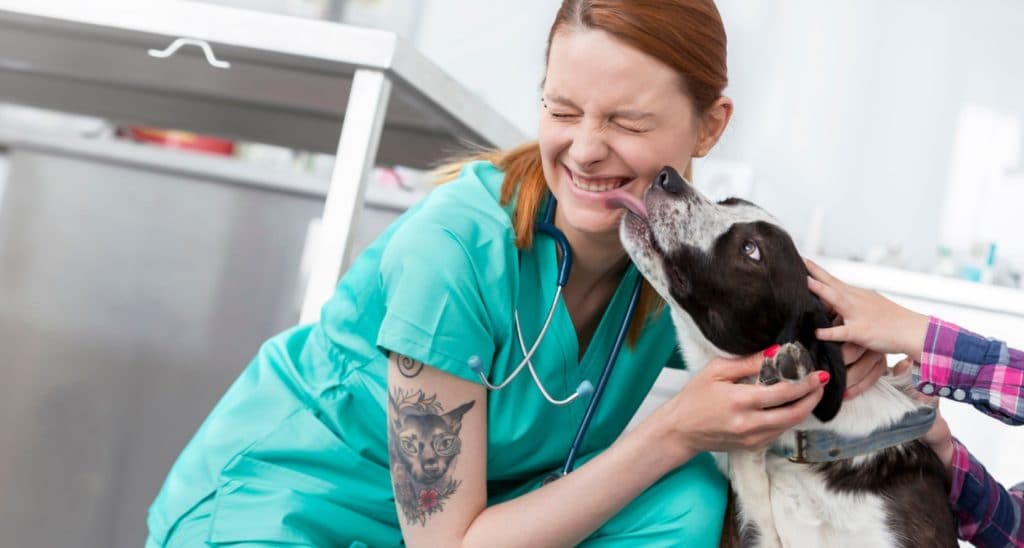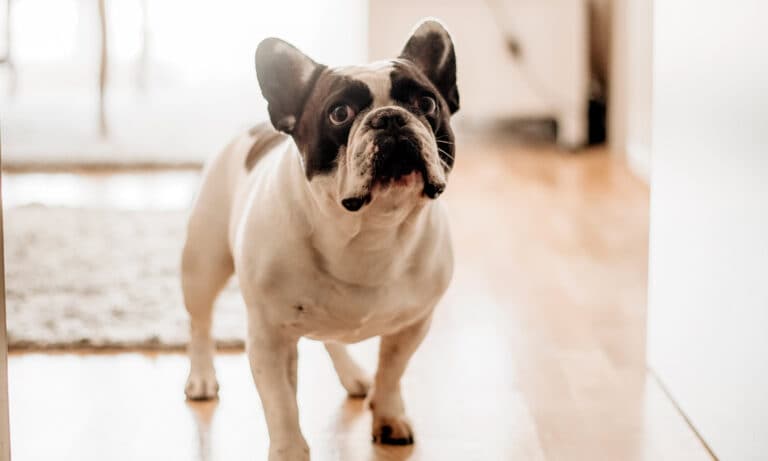If your cat or dog loved to go to the vet, would you feel differently about providing your pet with necessary routine health care? “America’s Veterinarian” Dr. Marty Becker is answering that question with a resounding “yes!” and so are tens of thousands of Fear Free Certified veterinary professionals around the country.
I am in the exam room with George, a brown, stocky dog who eyes me suspiciously from behind his mom’s legs. His ears are back, his tail is tucked under his belly, and every couple of breaths, he shudders quietly. His mom shares that he is petrified at the veterinarian’s office. He get so stressed, she has not brought him to the doctor in over a year even though he needs a rabies vaccine and a blood test. As a Fear Free veterinarian, I have seen cases like George’s where going to vet is so frightening that the pet isn’t getting the healthcare they deserve.
Stress can negatively affect the quality of life of our fur babies when they are at the vet and when they get home. In addition, patient stress inhibits the veterinary healthcare team’s ability to deliver quality medical care and effectively treat what ails your little one.
Enter Fear Free. For pets like George, Fear Free vet visits can hold the key to better healthcare and a happier life.
What Can My Pet Expect at a Fear Free Veterinary Clinic?
At the foundation of Fear Free is the creation of an environment that minimizes fear, anxiety and stress for pets, pet parents and veterinary healthcare team members. Veterinarians and veterinary healthcare team members who practice Fear Free are committed to addressing the entire pet, including their emotional state. They are also committed to advocating for your pet’s well-being and including you as an active part of the team.
A hospital that is Fear Free Certified should be welcoming to you and your pet. When you call to make the appointment, the Client Care Representative should ask you about your pet’s stress level and if you would prefer to wait in the car for your appointment. You might see dog treats on the counter, pheromone plug-ins and separate cat and dog waiting areas.
The exam room will have lots of treats to choose from, calming music playing and non-slip surfaces on the floor and table. The veterinary healthcare team is likely to talk to you about your pet’s likes and dislikes as well as explaining any signs of stress. The handling will be gentle and respectful. The veterinarian may send your pet home without finishing the visit if your pet is too stressed and have a discussion with you about anti-anxiety medications to give before your pets next visit.
Why Change the Vet Visit Experience?
In studies done on the behavioral effect of vet clinics on pets, researchers identified that 80 percent of dogs and 85 percent of cats experience fear, anxiety or stress at the veterinarian’s office. For over half of dogs, just entering the veterinary clinic causes visible signs of panic. Can you imagine panicking each time that you walked into the doctor’s office? You probably wouldn’t want to go to see the doctor very often.
Pets can remember the cues that signal a trip to the vet—like your stress, the carrier and even the previous route to the hospital—and will start the cascade of anxiety long before they arrive at the door. And the stress doesn’t stop when cats and dogs leave the clinic, either. Dogs can have increased cortisol (a stress hormone) 12 hours after a vet visit and over 50 percent of cats are stressed after they get home from seeing the vet.
When our pets are stressed, we get stressed too. Matter of fact, 38 percent of cat parents said that they themselves were stressed just thinking about taking their cat to the veterinarian. Less wellness visits with the family veterinarian equals more emergency care and more serious illnesses before diagnosis and treatment.
What Is the Significance of Fear, Anxiety and Stress for Pets?
Fear, anxiety and stress triggers a rush of neurotransmitters and hormones throughout the entire body within seconds. This flight or fight neurochemical wave causes major changes including increases in blood glucose (i.e., sugar), heart rate, respiratory rate (i.e., panting), blood pressure and body temperature. Within minutes, there are negative changes to the cells which help fight infections.
Certainly, this level of stress isn’t acceptable for our fur babies. If your dog or cat has to visit the veterinarian frequently, the stress of those visits could lead to chronic stress. Dogs and cats who have chronic stress can have decreased ability to heal and fight infections; gastrointestinal distress (e.g. diarrhea, vomiting, nausea); skin disease and urinary problems.
Plus, highly fearful and anxious patients are very difficult to handle. Coaxing and pulling the animal onto the scale and having them jump right off makes it very difficult to get an accurate weight. Additionally, fear and anxiety can increase blood pressure, heart rate, respiratory rate and temperature, leading to inaccuracies in recording a pet’s body condition.
For many pet parents, this is all the excuse we need to skip the annual veterinary visit, which can be a very serious mistake. Annual visits are not just for vaccines. These yearly checkups allow your veterinarian to perform a complete physical examination. So what seems like an insignificant checkup just might save your pets life, and will likely add to the quality and quantity of their days.
Veterinary professionals want to provide the best and most medically thorough experience for you and your pet. We understand the importance of the annual checkup to keep your pet healthy and extend their happy and healthy days. We are doing the best we can. But, is there a better way?
What Is a Fear Free Certification?
Fear Free Certified professionals are educated and trained to use transformative techniques that focuses on an environment that promotes relaxation, handling strategies that minimize stress and delivering well-timed food rewards for endless positive reinforcement. These techniques change the veterinary experience from fearful to pleasurable for animals. When animals are more relaxed in the veterinary setting, we get more information from our physical exam and more reliable data from our tests.
Animals will remember the positive experience, making the next visit something they look forward to instead of dread. Pet parents are delighted when their beloved animals have a positive experience and their stress diminishes. They are more likely to return for future care and even feel better about the cost.
Who Can Become Fear Free Certified?
Fear Free now offers both online and in-person courses to the entire veterinary team. In addition to individuals, entire veterinary practices can become Fear Free Certified. Fear Free has been so successful that they have expanded their certification offerings to include animal shelters, animal trainers and groomers.
After passing a nine-hour course written by veterinary behaviorists and veterinarians, the veterinary professional can call themselves Fear Free Certified. Each year, certified professionals must recertify with either a set of courses or a test. The Fear Free certification encompasses many topics, such as identification of stress in dogs and cats, gentle restraint, proper use of anxiolytic medications and supplements, modification of behavior and considerate communication with pet parents. While the first certifications were focused on dogs and cats, there is now a shelter certification as well as avian course and an equine course that is coming soon.
History of the Fear Free Certification
Dr. Marty Becker is the founder of Fear Free. Graduating from veterinary school in 1980, Dr. Becker has spent four decades practicing veterinary medicine in northern Idaho. In addition to practicing medicine and owning veterinary hospitals, Dr. Becker has written 23 books that have sold over seven million copies, is an adjunct professor at multiple veterinary schools, and lectures to veterinarians around the world.
Dr. Becker recognized that both pets and people experienced fear, anxiety and stress as a regular side effect of the veterinary experience and set on a journey of creating a better way. He assembled a team of the world’s leading veterinary experts and created this unprecedented comprehensive education platform on emotional well-being, enrichment, and the reduction of fear, anxiety and stress in pets.
One Dog’s Experience with Fear Free
As a Fear Free veterinarian, I have encountered plenty of pets (and pet parents!) who have benefited from this enhanced level of care.
Remember George? He was definitely in need of some Fear Free treatment! As George eyed me, I tossed little bits of freeze-dried chicken to him. It took a couple of minutes, but he ate one piece and then the next. The trembling had stopped, but he didn’t trust me enough to move in my direction.
Soon, it was time for the physical examination and blood draw. I had to pull out all of the stops. From the counter, I grabbed squeeze cheese in a can. Not the dog stuff. The stuff from the grocery store. I smeared it into a paper bowl with a pretzel stick. Then, I handed the bowl to Mom. Now she was the one looking at me suspiciously. With her permission, we brought the blood draw to George instead of taking George from his mom. She held the bowl for George to lick while we did the physical examination. We used a leash and light restraint, keeping our bodies around him without holding onto him tightly.
When we were done, George’s mom looked at me and said, “When are you going to draw the blood?” Imagine her shock when I told her that we were done! True story.
How Can I Find Fear Free Certified Veterinary Professionals?
You can use the search field at www.fearfreepets.com or www.fearfreehappyhomes.com to find a Fear Free veterinary professional or practice in your area. Individuals may be certified, which means that the person practices Fear Free techniques. There are also Fear Free Certified hospitals in which the entire hospital is committed to Fear Free veterinary visits. Because a particular doctor is listed as Fear Free Certified, that doesn’t mean that the entire hospital or even any other team members are Fear Free Certified.
Once you find a Fear Free veterinarian, call the clinic and ask how many of their team members are Fear Free Certified. You can always request a specific doctor to make sure that Fear Free techniques are used.
Pet professionals enter this line of work because they love animals. They too experience anxiety and stress when their clients and patients have a negative experience in their care. Using these techniques, dogs and cats that had dreaded a trip to the vet have been transformed into animals that pull their person through the door or leap out of the carrier to greet the veterinary staff.
When pets and their people enjoy their services, the veterinarian and veterinary staff experience better job satisfaction. The wagging tails and smiling faces are long overdue for all of us.
Read more:
Share:









